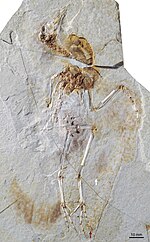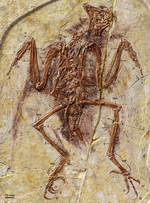 | Ornithothoraces is a group of avialan dinosaurs that includes all enantiornithes ("opposite birds") and the euornithes ("true birds"), which includes modern... 6 KB (447 words) - 17:35, 21 April 2024 |
 | in some species, can fly on the same day they hatch from their eggs. Enantiornithes and pterosaurs[citation needed] were also capable of flight soon after... 17 KB (2,176 words) - 17:12, 4 April 2024 |
 | Sereno, who made it the group of all animals closer to birds than to Enantiornithes (represented by Sinornis). This definition currently includes similar... 12 KB (671 words) - 11:38, 26 March 2024 |
 | Enantiornithes, or "opposite birds", so named because the construction of their shoulder bones was in reverse to that of modern birds. Enantiornithes... 233 KB (23,344 words) - 02:03, 27 April 2024 |
 | including mousebird relatives (Sandcoleidae), Messelasturidae and some Enantiornithes, indicating possible convergent evolution in some cases, and common... 46 KB (4,771 words) - 17:52, 22 March 2024 |
 | 1981, Dr. Cyril Walker defined the clade enantiornithes and Gobipteryx was reclassified as an enantiornithes bird. In 1996, Evgeny Kurochkin described... 10 KB (1,077 words) - 12:00, 1 March 2024 |
phylogenetic analyses, Wang et al. recovered Imparavis as a member of the Enantiornithes, as the sister taxon to Yuornis in a clade also containing Gobipteryx... 5 KB (247 words) - 01:15, 28 March 2024 |
 | preserved). Conversely, it is thought that some extinct birds like Enantiornithes did not have gizzards. The mullet (Mugilidae) found in estuarine waters... 14 KB (1,827 words) - 12:27, 23 March 2024 |


